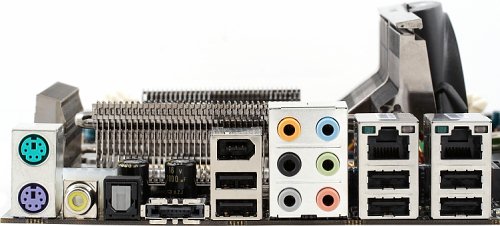XFX nForce 790i Ultra 3-Way SLI and Zotac nForce 790i-Supreme
|
System monitoring (Winbond W83627DHG, in BIOS Setup)
- Voltages on a processor, memory, Northbridge, battery, +3.3, and +12 V
- Amperage of the 12 V line
- Rotational speed of five fans, two of them allow automatic fan speed control, the others can be controlled manually
- CPU and board temperatures (by the corresponding embedded sensors)
- Automatic fan speed control (for the CPU cooler and one system fan) depending on temperature: you can specify the target temperature of a CPU (51-100/80°C), when the fan speeds up to maximum, as well as a temperature level (0-50°C), below which the fan will rotate at a specified speed (0-100%). In between these temperature thresholds the fans increase their speed proportionally to CPU temperature.
Besides, the motherboard allows to control rotational speed of three system fans directly (unlike the popular automatic control): you can set the speed at 10% steps.
Proprietary Windows utilities (NVIDIA System Performance and NVIDIA System Monitor - they work with all motherboards on NVIDIA chipsets) monitor most system parameters, such as bus clock rates, memory timings, voltages, temperatures, fan speed, etc. Moreover, many parameters, responsible for system performance, can be modified in real time, including overclocking. There is little sense in listing all monitored/adjustable parameters. It's really huge. Besides, if you run these programs on a new chipset (not yet supported), they may often display rubbish instead of anticipated values or even fail to read some information.
Onboard ports, sockets, and connectors
- Socket 775, support for all Celeron, Pentium, and Core 2 processors with FSB up to 1600 MHz, including models on Wolfdale/Yorkfield cores
- 4 x DDR3 SDRAM DIMM (up to 8 GB of DDR3-800/1066/1333; dual channel mode is supported, when both slots are filled), if EPP 2.0 memory is used, you can specify higher operating frequencies, but memory faster than DDR3-1800 is officially supported only by two black slots
- 3 x PCIEx16 for graphics cards: they all operate in x16 mode, two of them comply with the second version of the PCI Express 2.0 standard (with proportionally increased speed), you can build SLI with two or three cards
- 2 x PCIEx1
- 2 x PCI
- Power connectors: standard ATX 2.2 (24 pins, you can also plug a regular 20-pin ATX 2.03 connector) and 8-pin EPS12V for a processor (you can also plug a regular 4-pin ATX12V connector even without an adapter)
- 1 x FDD, it's installed on its side, so it's convenient to plug cables, even if you have long expansion cards installed
- Chipset-based IDE (Parallel ATA) for two ATA133 devices
- 7 x SATA-II (Serial ATA II) for seven SATA300 devices, one of them is based on the additional JMicron controller,the other six are based on the chipset; hard drives connected to the latter can form RAID 0, 1, 0+1, and 5 (a couple of connectors are installed on their sides to make it more convenient to plug cables with expansion cards already installed)
- Two connectors for brackets with 4 additional USB ports
- Connector for a rear panel bracket with 1 x additional FireWire
- Connector for a COM port on a bracket
- Connectors for analog audio ins and outs on the front panel
- Connector for a bracket with S/PDIF-Out
- Another audio connector with an unknown function
- Six(!) fan headers (5 of them offer rpm control), 4-pin header for a CPU fan and one 3-pin header allow automatic rpm control, for the other three headers you can specify fan speed manually.
Back panel (left to right, blockwise)
 Click for the rear view. Click for the rear view.
- PS/2 mouse and keyboard
- 1 x Coaxial and 1 x Optical (Toslink) S/PDIF-Outs
- 1 x eSATA
- 2 x USB and 1 x FireWire (6-pin)
- 6 x analog audio jacks: Line-In, Front, Mic-In, Rear, Center/Sub, Side
- 2 x USB and 1 x RJ-45 (Gigabit Ethernet)
- 2 x USB and 1 x RJ-45 (Gigabit Ethernet)
Write a comment below. No registration needed!
|
|
 |
|
|
|
